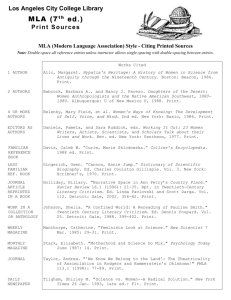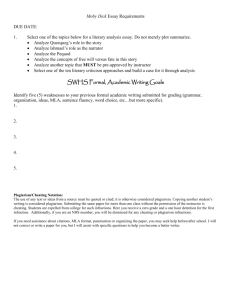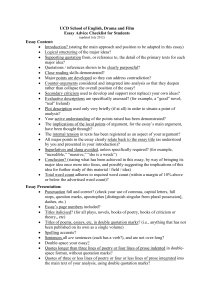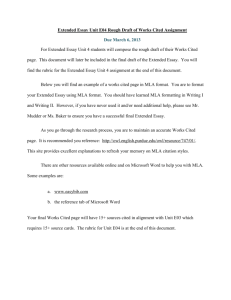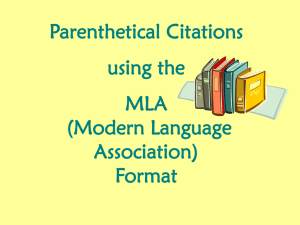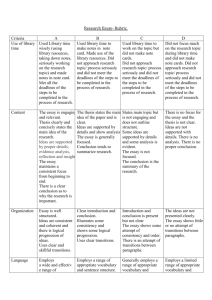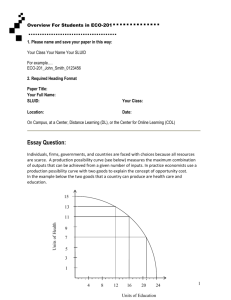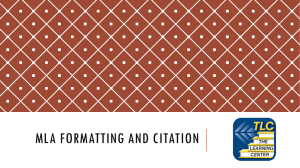mla format guidelines
advertisement
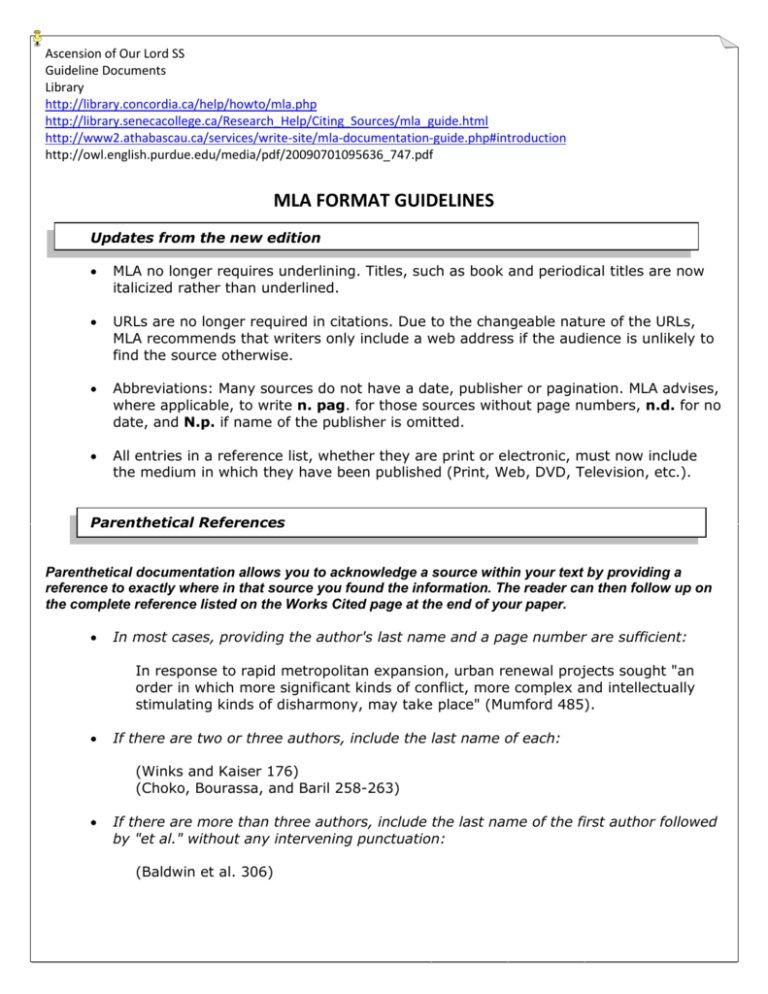
Ascension of Our Lord SS Guideline Documents Library http://library.concordia.ca/help/howto/mla.php http://library.senecacollege.ca/Research_Help/Citing_Sources/mla_guide.html http://www2.athabascau.ca/services/write-site/mla-documentation-guide.php#introduction http://owl.english.purdue.edu/media/pdf/20090701095636_747.pdf MLA FORMAT GUIDELINES Updates from the new edition MLA no longer requires underlining. Titles, such as book and periodical titles are now italicized rather than underlined. URLs are no longer required in citations. Due to the changeable nature of the URLs, MLA recommends that writers only include a web address if the audience is unlikely to find the source otherwise. Abbreviations: Many sources do not have a date, publisher or pagination. MLA advises, where applicable, to write n. pag. for those sources without page numbers, n.d. for no date, and N.p. if name of the publisher is omitted. All entries in a reference list, whether they are print or electronic, must now include the medium in which they have been published (Print, Web, DVD, Television, etc.). Parenthetical References Parenthetical documentation allows you to acknowledge a source within your text by providing a reference to exactly where in that source you found the information. The reader can then follow up on the complete reference listed on the Works Cited page at the end of your paper. In most cases, providing the author's last name and a page number are sufficient: In response to rapid metropolitan expansion, urban renewal projects sought "an order in which more significant kinds of conflict, more complex and intellectually stimulating kinds of disharmony, may take place" (Mumford 485). If there are two or three authors, include the last name of each: (Winks and Kaiser 176) (Choko, Bourassa, and Baril 258-263) If there are more than three authors, include the last name of the first author followed by "et al." without any intervening punctuation: (Baldwin et al. 306) If the author is mentioned in the text, only the page reference needs to be inserted: According to Postman, broadcast news influences the decision-making process (5163). If there is no author, as is the case with some web pages, include either the whole title of the work in the text or use a shortened form of the title in parentheses, using the first words of the title. Italicize the titles of books and place the titles of articles in quotation marks: Voice of the Shuttle has many electronic sources. If there are no page numbers in your source, as is the case with some web pages, you can indicate the section or paragraph number in your parenthetical reference. If there are no such reference marks, do not include them in your reference. Do not count unnumbered paragraphs: Winston argues that "Rourke has lowered his defenses" (par. 29). When citing a quotation which is cited in another source, indicate the source you actually consulted in your parenthetical reference and in your works cited. Use the abbreviation qtd. in to indicate that the information has been quoted in another source: Landow admitted that there was "work to be done" (qtd. in Rogers 333). Formatting Quotes Embedded short quote: Hamlet questioned the idea of suicide when he asked himself: “To be, or not to be” (2.3.44). “He was obeyed,” writes Joseph Conrad of the company manager in Heart of Darkness, “yet he inspired neither love nor fear, nor even respect”(87). Long quotes more than three lines must be set off from text by starting a new line and indenting in a block. Do not use quotation marks. Double space. At the conclusion of Lord of the Flies, Ralph and the other boys realize the horror of their actions: The tears began to flow and sobs shook him. He gave himself up to them now for the first time on the island; great, shuddering spasms of grief that seemed to wrench his whole body. His voice rose under the black smoke before the burning wreckage of the island; and infected by that emotion, the other little boys began to shake and sob too. (Golding, 186) When a verse quotation begins in the middle of a line, the partial line should be positioned where it is in the original and not shifted to the left margin. In a poem on Thomas Hardy (“T.H.”), Molly Hilden recalls her encounter with a “young dog fox” one morning: I remember he glanced at me in just that way, independent and unabashed, the handsome sidelong look that went round and about but never directly met my eyes, for that would betray his soul. He was not being sly, only careful. (43-48) Use double quotation marks around quotations incorporated into the text, single quotation marks around quotations within those quotations. In “Memories of West Street and Lepke,” Robert Lowell, a conscientious objector (or “C.O.”), recounts meeting a Jehovah’s Witness in prison: “’Are you a C.O.?’ I asked a fellow jailbird. / ‘No,’ he answered, I’m a J.W.’” (38-39). Use square brackets when changing anything within a quotation or adding your own words for clarification. In the first act he soliloquizes, “Why she would hang on him [Hamlet’s father]/ As if increase of appetite had grown / By what it fed on . . .” (1.3.30-32). Dialogue. Begin each part of the dialogue with the appropriate character’s name indented 10 spaces from the left margin and written in all capital letters. Follow the name with a period, and start the quotation. Indent all following lines in that character’s speech an additional three spaces. When the dialogue shifts to another character, start a new line indented ten spaces from the left. Keep this pattern for the duration of the quotation. Marguerite Duras’s screenplay for Hiroshima mon amour suggests at the outset the profound difference between observation and experience: HE. You saw nothing in Hiroshima. Nothing SHE. I saw everything. Everything …The hospital, for instance, I saw it. I’m sure I did. There is a hospital in Hiroshima. How could I help seeing it? HE. You did not see the hospital in Hiroshima. You saw nothing in Hiroshima. (2505-2506) Paraphrasing and summarizing: There are instances when you may not be directly quoting from a source, but are still required to acknowledge the source of the information. The following is a paraphrase of a quote from Moers: Shelley’s novel, Frankenstein, incorporates ideas about education advocated by her parents, Mary Wollstonecraft and William Godwin ( Moers 94). Works cited - General guidelines The alphabetical list of works cited that appears at the end of your paper contains more information about all of the sources you've cited allowing readers to refer to them, as needed. The main characteristics are: The list of Works Cited must be on a new page at the end of your text Entries are arranged alphabetically by the author's last name or by the title if there is no author Titles are italicized (not underlined) and all important words should be capitalized Entries are double-spaced (for the purposes of this page, single-spacing is used) Each entry must include the publication medium. Examples include: Print, Web, DVD, and Television. Book with 1 author Mumford, Lewis. The Culture of Cities. New York: Harcourt, 1938. Print. Book with 2 or 3 authors Francis, R. Douglas, Richard Jones, and Donald B. Smith. Destinies: Canadian History since Confederation. Toronto: Harcourt, 2000. Print. Book with 4 or more authors Baldwin, Richard et al. Economic Geography and Public Policy. Princeton: Princeton UP, 2003. Print. Two or more books by the same author: Replace the author's name by three hyphens and arrange alphabetically by the book's title: Postman, Neil. Amusing Ourselves to Death: Public Discourse in the Age of ShowBusiness. New York: Viking, 1985. Print. ---. The Disappearance of Childhood. New York: Vintage, 1994. Print. Anthology or compilation Abate, Corinne S., ed. Privacy, Domesticity, and Women in Early Modern England. Burlington, VT: Ashgate, 2003. Print. Work in an anthology or an essay in a book Naremore, James. "Hitchcock at the Margins of Noir." Alfred Hitchcock: Centenary Essays. Ed. Richard Allen and S. Ishii-Gonzalès. London: BFI, 1999. 263-77. Print. Book by a corporate author: Associations, corporations, agencies and organizations are considered authors when there is no single author. Organisation for Economic Co-operation and Development. Action against Climate Change: The Kyoto Protocol and Beyond. Paris: OECD, 1999. Print. Article in a reference book or an entry in an encyclopedia: If the article/entry is signed, include the author's name; if unsigned, begin with the title of the entry Guignon, Charles B. "Existentialism." Routledge Encyclopedia of Philosophy. Ed. Edward Craig. 10 vols. London: Routledge, 1998. Print. Article reprinted in a reference book online Carlson, Eric W. “The Range of Symbolism in Poetry.” The South Atlantic Quarterly 48.3 (1949): 442-52. Rpt. in Poetry Criticism. Ed. Jane Kelly Kosek and Christine Slovey. Vol. 13. Detroit: Gale, 1995. 83-84. Literature Criticism Online. Web. 18 Oct. 2009. A translation Kafka, Franz. Metamorphosis. Trans. and Ed. Stanley Corngold. New York: Bantam, 1972. Print. A government publication Canada. Dept. of Foreign Affairs and International Trade. Freedom from Fear: Canada's Foreign Policy for Human Security. Ottawa: DFAIT, 2002. Print. United Nations. Dept. of Economic and Social Affairs. Population Division. Charting the Progress of Populations. New York: UN, 2000. Print. Book in a series Bloom, Harold, ed. André Malraux. New York: Chelsea House, 1988. Print. Modern Critical Views. Article in a journal. Article retrieved in print/paper format: Ferrer, Ada. "Cuba 1898: Rethinking Race, Nation, and Empire." Radical History Review 73 (1999): 22-49. Print. Man, Glenn K. S. "The Third Man: Pulp Fiction and Art Film." Literature Film Quarterly 21.3 (1993): 171-178. Print. Article retrieved on the Web: Sehmby, Dalbir S. "Wrestling and Popular Culture." CCLWeb: Comparative Literature and Culture 4.1 (2002): n. pag. Web. 29 Mar. 2009. Article retrieved in a library database: Provide the same information as you would for a printed journal article and add the name of the database in italics, and indicate the publication medium as Web and the date of access. NOTE - If there are no page numbers, or if the page numbers for each article in a journal appear in a new sequence for each item rather than continuously across the entire issue, write n. pag. Brennan, Katherine Stern. "Culture in the Cities: Provincial Academies during the Early Years of Louis XIV's Reign." Canadian Journal of History 38.1 (2003): 19-42. CBCA Complete. Web. 29 Mar. 2004. Dussault, Marc and Bruce G. Barnett. "Peer-assisted Leadership: Reducing Educational Managers' Professional Isolation." Journal of Educational Administration 34.3 (1996): 5-14. ABI/INFORM Global. Web. 29 Mar. 2004. Heming, Li, Paul Waley, and Phil Rees. "Reservoir Resettlement in China: Past Experience and the Three Gorges Dam." The Geographical Journal 167.3 (2001): 195-212. Academic Search Premier. Web. 29 Mar. 2004. Article in a newspaper or magazine Semenak, Susan. "Feeling Right at Home: Government Residence Eschews Traditional Rules." Montreal Gazette 28 Dec. 1995, Final Ed.: A4. Print. Driedger, Sharon Doyle. "After Divorce." Maclean's 20 Apr. 1998: 38-43. Print. An entire Web site Linder, Douglas O. Famous Trials. Univ. of Missouri Kansas-City Law School, 2009. Web. 29 Apr. 2009. A page on a Web site: An entry for a nonperiodical item found on the Web contains the following: Last name, First name. "Document title if available." Title of the overall Web site. Version or edition if available. Publisher or N.p. to designate no publisher, publication date or n.d. to mean no date. Web. Date of access. If you cannot find some of this information, include only what is available. "Joyce Wieland." Celebrating Women's Achievements: Women Artists in Canada. National Library of Canada, 2000. Web. 29 Mar. 2004. Cassidy, Penny. "You Can't Read That." NBC New York. NBC Universal, 18 Apr.2009. Web. 29 Apr. 2009. A review Kirn, Walter. "The Wages of Righteousness." Rev. of Cloudsplitter, by Russell Banks. New York Times Book Review 22 Feb. 1998: 9. Print. Kauffmann, Stanley. "A New Spielberg." Rev of Schindler's List, dir. Steven Spielberg. New Republic 13 Dec. 1993: 30. Print. Television or radio program "Scandal of the Century." Narr. Linden MacIntyre. The Fifth Estate. CBC Television. 23 Jan. 2002. Television. Sound recording Ellington, Duke. "Black and Tan Fantasy." Music is My Mistress. Musicmasters, 1989. CD. Film, videorecording or DVD The Shining. Dir. Stanley Kubrick. Perf. Jack Nicholson, Shelley Duvall. Warner Bros., 1980. Videocassette. Macbeth. Dir. Roman Polanski. Perf. Jon Finch, Francesca Annis, and Nicholas Selby. 1971. Columbia, 2002. DVD. Musical composition, published score Beethoven, Ludwig van. Symphony no. 4 in B-flat major, op. 60. Mineola, NY: Dover, 2001. Print. Work of art, photographed, in a book Cassatt, Mary. Mother and Child. 1890. Wichita Art Museum, Wichita. American Painting: 1560-1913. By John Pearce. New York: McGraw, 1964. Slide 22. Formatting Your Paper Titles and title pages All of your essays must have a title that reflects the content and main idea of the essay. The essay topic is not the title; the title of the poem, novel, play or other piece of literature you are writing about is also not the title of your essay. MLA documentation style does not require a title page; however, you do need to include the following information on the first page of your assignment: Your name The tutor’s or professor’s name The course name and number The date you submit the essay Place this information on the top left of the page. This should be double-spaced. Doublespace again and centre the title of the essay on the page. Subsequent pages All pages in your essay, including the works cited page, and the title page must have your last name as well as the page number in the top right corner. Krzyzanowski 2 Continue writing your essay on the line directly below your name when in double space mode. Paragraph Structure When starting a new paragraph make sure to indent five spaces by hitting the “tab” button. There is no need to add extra lines of space between paragraphs; simply continue on the next double spaced line.
